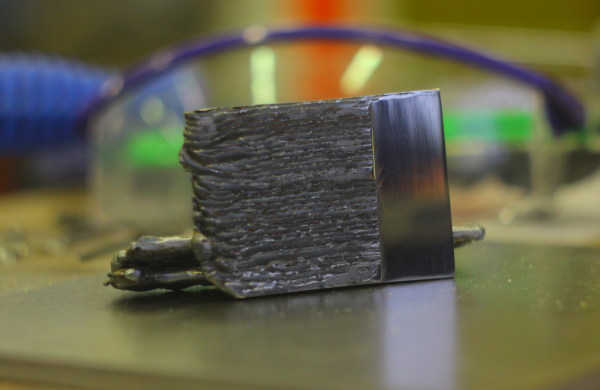A few things are required for effective extrusion-style 3d printing materials:
- It must stay where placed by the nozzle long enough to harden (or, alternately for pastes and such, have a shear-thinning or thixotropic viscous profile so it will not flow under its own weight).
- If using a filament extruder, it must have a wide range of viscosity that varies gradually over a considerable temperature range. This is necessary to develop the proper "cap zone" semi-melt shearing behavior that allows the incoming filament to act like a piston and generate pressure upstream of the nozzle. Pellet extruders have a similar requirement but related to screw/wall shearing rather than filament/wall shearing. If using neither filament nor pellets, such as clay printers, the material must be pumpable by a positive-displacement pump. (It is possible to pump molten metal, but the cost is quite high.)
- It must form some kind of bond with previously-deposited solid material, without needing to be in a state that will rapidly flow and lose shape.
- It must have some combination of low shrinkage, the ability to creep at the printer's ambient temp, and/or low stiffness that allows consecutive layers to be stacked without an unacceptable amount of warping.
Liquid metals tend to have a conflict between "Staying where you put it" and "bonding with the previous layer." In order for deposited metal to fully bond, the interface material needs to reach the melting point so a true fusion weld occurs. And in order to supply enough heat to remelt the interface without an additional heat source like an arc, the deposited molten metal needs to be very hot. So it will tend to run while it cools. High density and high heat capacity makes it run fast and cool slowly.
Pretty much every DIY metal 3d print (such as made by wire-feed MIG welders) ends up looking something like this:
 https://3dprint.com/29944/diy-metal-printing-garage/
https://3dprint.com/29944/diy-metal-printing-garage/
In comparison, polymers have long molecular chains that allow them to "diffusion weld" and adhere WITHOUT fully remelting the interface. Molten liquid plastic will stick to solid plastic quite effectively. The interface only needs to get hot enough for appreciable diffusion to intertwine the molecular chains. This will occur between the glass point and melting point, without true fusion occurring. So you can print molten plastic at a temperature where it will stay in place long enough to harden, and still get good bonding.
Metals also tend to be very stiff, which encourages warping. It is difficult to build a heated environment of sufficient temperature to properly stress-relieve the thermal contraction stress as the print progresses, whereas with plastic a heated build plate and warm enclosure can permit warping stresses to start relaxing as the print progresses.
It is possible to "FDM-style" 3d print filament/wire made of metal alloys that have a wide range between solidus and liquidus. It has been done using solder and similar alloys. However, between the warping stresses, poor layer bonding from inadequate interface re-melting, and use of soft low-melting alloys, the resulting printed parts will usually end up being weaker than if they had simply been printed in a strong plastic. For example, PEEK is nearly as strong as aluminum, and carbon fiber or fiberglass composite plastics can exceed metals on various performance metrics. So what's the point of printing with weak, brittle metal alloys?
Over the years, lots of people have tried FDM-style metal printing, but no one has found it worthwhile to pursue in the long run. More typical DIY metal printing approaches like 3D MIG welding following by cleanup machining will produce better results.
